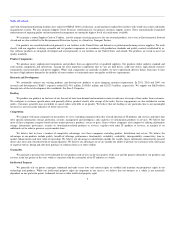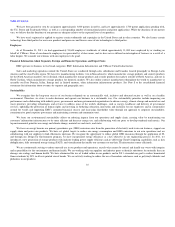EMC 2011 Annual Report Download - page 20
Download and view the complete annual report
Please find page 20 of the 2011 EMC annual report below. You can navigate through the pages in the report by either clicking on the pages listed below, or by using the keyword search tool below to find specific information within the annual report.
Table of Contents
Our business could be materially adversely affected as a result of the risks associated with acquisitions and investments.
As part of our business strategy, we seek to acquire businesses that offer complementary products, services or technologies. These acquisitions are
accompanied by the risks commonly encountered in an acquisition of a business, which may include, among other things:
• the effect of the acquisition on our financial and strategic position and reputation;
• the failure of an acquired business to further our strategies;
• the failure of the acquisition to result in expected benefits, which may include benefits relating to enhanced revenues, technology, human resources,
cost savings, operating efficiencies and other synergies;
• the difficulty and cost of integrating the acquired business, including costs and delays in implementing common systems and procedures and costs
and delays caused by communication difficulties or geographic distances between the two companies' sites;
• the assumption of known or unknown liabilities of the acquired business, including litigation-related liability;
• the potential impairment of acquired assets;
• the lack of experience in new markets, products or technologies or the initial dependence on unfamiliar supply or distribution partners;
• the diversion of our management's attention from other business concerns;
• the impairment of relationships with customers or suppliers of the acquired business or our customers or suppliers;
• the recoverability of benefits from goodwill and intangible assets and the potential impairment of these assets;
• the potential loss of key employees of the acquired company; and
• the potential incompatibility of business cultures.
These factors could have a material adverse effect on our business, results of operations or financial condition. To the extent that we issue shares of our
common stock or other rights to purchase our common stock in connection with any future acquisition, existing shareholders may experience dilution.
Additionally, regardless of the form of consideration issued, acquisitions could negatively impact our net income and our earnings per share.
In addition to the risks commonly encountered in the acquisition of a business as described above, we may also experience risks relating to the
challenges and costs of closing a transaction. Further, the risks described above may be exacerbated as a result of managing multiple acquisitions at the same
time.
We also seek to invest in businesses that offer complementary products, services or technologies. These investments are accompanied by risks similar
to those encountered in an acquisition of a business.
Our pension plan assets are subject to market volatility.
We have a noncontributory defined benefit pension plan assumed as part of our Data General acquisition. The plan's assets are invested in common
stocks, bonds and cash. The expected long-term rate of return on the plan's assets was 6.75%. This rate represents the average of the expected long-term rates
of return weighted by the plan's assets as of December 31, 2011. We continue to shift the asset allocation to lower the percentage of investment in equity
securities and increase the percentage of investments in long-duration fixed-income securities. The effect of such change could result in a reduction in the
long-term rate on plan assets and an increase in future pension expense. As of December 31, 2011, the ten-year historical rate of return on plan assets was
5.5%, and the inception to date return on plan assets was 9.8%. In 2011, we experienced an 8.9% gain on plan assets. Should we not achieve the expected rate
of return on the plan's assets or if the plan experiences a decline in the fair value of its assets, we may be required to contribute assets to the plan which could
materially adversely affect our results of operations or financial condition.
Our business could be materially adversely affected by changes in regulations or standards regarding energy use of our products.
We continually seek ways to increase the energy efficiency of our products. Recent analyses have estimated the amount of global carbon emissions that
are due to information technology products. As a result, governmental and non-governmental organizations have turned their attention to development of
regulations and standards to drive technological improvements and reduce such amount of carbon emissions. There is a risk that the development of these
standards will not fully address the complexity of the technology developed by the IT industry or will favor certain technological approaches. Depending on
the regulations or standards that are ultimately adopted, compliance could materially adversely affect our business, results of operations or financial condition.
19
























